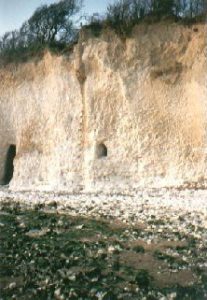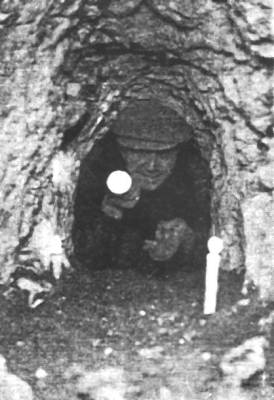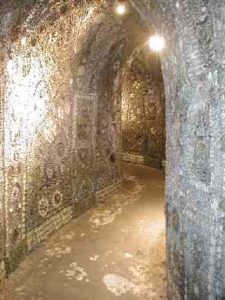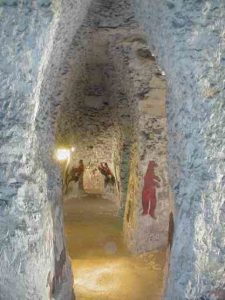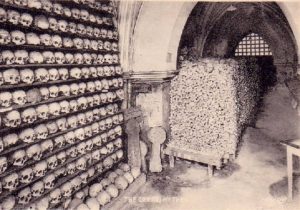Whilst other parts of Britain have their tales of secret passages, for sheer numbers they are easily surpassed by the old smuggling counties of Kent and Sussex. Unfortunately for the romantics amongst us, the truth is that most of these sites have much humbler origins as drainage tunnels, cellars, follies, etc. Smugglers were practical men and it was far easier to carry goods at night on packhorses rather than drag them for long distances along wet, low passages. There is no denying that some passages were excavated for carrying and storing smuggled goods but a little thought will soon discount most of the rumours. just about every church and large house has its accompanying secret passage rumour but nobody seems to know where it is! Take any two unexplained holes and someone will link them with a secret passage, be it 100 yards or 40 miles. For the dedicated hunter of secret passages, a host of rumours can be found in the publications of Chelsea Speleological Society (see bibliography) but a few examples are included below.
Smugglers Passages
The Smugglers’ Farm Hotel near Herstmonceux, Sussex is a converted farmhouse dating from around 1600. In the Coffee Room is a primitive winch sited over a shallow shaft that is blocked at the bottom. The shaft is reputed to have led to a passage which came out on Pevensey Marshes and which was used by smugglers to bring their goods to a safe haven.
In the cliffs at Pegwell Bay, Kent there is a small opening about 8ft above the level of the beach. This leads to 500ft of low, artificial tunnel that passes under one shaft and is blocked at a second. It is called Frank Illingworth’s Tunnel after the man who explored and wrote about it in 1938, his opinion being that it was driven by smugglers. At that time, it apparently went much further than today and Illingworth found an ancient pistol and 3 buttons from an Exciseman’s tunic. The tunnel slopes slightly towards the beach and, since the cliff is continuously being eroded away, it is possible that it emerged at beach level when in use. The shaft is next to a demolished house and it is possible that smuggled goods were taken along the tunnel from the beach and up the shaft.
Secret Passages
A passage exists at Roedean School, Sussex that connects the school with the beach. It was built in 1910 through chalk and is 3ft wide x 6ft high, being electrically lit throughout. A chamber has been excavated at the beach end as a changing room. The Roebuck Hotel at Wych Cross, Sussex is said to have a concealed staircase behind the fireplace in the bar. This leads down to cellars and out to Dane Hill via a passage.
Follies
Margate in Kent has more than its share of strange underground places. It is not known when the Margate Grotto was excavated but it was re-discovered in 1835 when a workman dug through the cover of what he thought was a well. The landowner, Mr Newlove, was too portly to enter the hole but his son was lowered 20ft to the floor of a tunnel. To his amazement, he found himself wandering around a sensationaily decorated grotto where the walls were decorated with sea shells in all types of pattern.
The Grotto is open to the public and modern visitors enter via a specially constructed entrance. The shapes of flowers, hearts and trees abound right up to the end, some 104ft from the entrance. In the absence of scientific dating, the grotto has been subject to much fanciful speculation that has linked it to the Trojans and Phoenicians. It is much more recent than that but still worth a visit.
Nearby in Cliftonville is King Vortigern’s Cavern that is also open to the public. Like the Grotto, it was re-discovered accidentally in 1798 but the paintings were added subsequently by successive owners. The star attraction is a life size painting of the King which fluoresces under ultraviolet light. The tunnels are on more than one level and there are two curious circular chambers. The guides would have us believe that the latter were for holding prisoners but they are more likely to have been ice wells.
In the grounds of Kent County Nurseries at Challock lies what is termed the Challock Exotic Grotto. It is claimed to be a Neolithic flint mine and there is a spiral staircase <pic> descending the 30ft shaft, at the base of which three large chambers have been decked out with plants, statues and waterfalls. It is in reality a chalkwell. Perhaps 200 years old, but it is well preserved and worth a visit to see how they were excavated (if you can ignore the shrubbery!).
The crypt of Hythe Church is not strictly speaking below ground but for those with a macabre interest it is worth a visit as it contains an ossuary. Some 1,100 skulls and 8,000 thigh-bones, thought to be a relic of the Black Death, have been arranged around the walls in gruesome decorative piles. The original date of the church is 1100 AD so some of these bones may be of considerable antiquity.
Conduits
Greenwich Park in London has plenty of underground phenomena but there are a number of unique conduits which were dug in the sub-surface gravel to collect water for a nearby Royal Palace. They average 5ft high x 2ft 6ins wide and are brick-lined with an arched roof. Gaps were left in the bottom three courses of bricks to allow water to percolate through and this was channelled along a lead-lined trough in the floor. Some conduits are long, single passages, up to a quarter of a mile long, with occasional manholes to the surface. Others have many branches but they are all fulfilling their original purpose; where the water goes to now is something of a mystery. Access is strictly restricted by the park authorities.
Another use for conduits was to take water away from buildings. The large roof area of Canterbury Cathedral collected a great volume of rainwater and this is directed into a series of old underground conduits. Like at Greenwich, they are mostly brick-lined with an arched roof and have a number of access manholes.
Horizontal Wells
This seems to be an anomaly at first sight but tunnel systems have been driven into the chalk at a number of places to collect water. At Terlingham near Folkestone, a reservoir is supplied by water issuing from such a tunnel. This consists of nearly 700 yards of passage and, at intervals of 8ft, holes have been drilled for 25ft up into the roof. These tap water bearing layers of rock above and the water pours down into the passage and out to the reservoir.
Channel Tunnel
At the time of writing, the new Channel Tunnel has not yet been finished but this attempt is only one of many in the past. Smaller versions exist at Abbotts Cliff near Folkestone and Shakespeare Cliff near Dover. These were started in the 1880s by Sir Edward Watkin but the attempt was stopped following political pressure over fear of invasion. By walking along the seafront from Folkestone towards Dover, a series of short-gated tunnels are passed on the left which drain the bed of the railway track above.
One of these intersects the old Channel Tunnel that is accessible for over 500ft until it becomes flooded. It was only driven for a short distance but it was one of the first instances of using a tunnelling machine and this has left a circular cross-section, 7ft in diameter. Nearby is the site of a further attempt in 1922 which used a boring machine designed to tunnel under the German lines in the First World War. This only went for 400ft before the machine broke down and the latter can be seen sticking out of the hillside where it was abandoned. It was quite a monster machine for its day and drove a 12ft diameter circular tunnel at 12ft per hour.
Miscellaneous
Situated beneath The Point at Blackheath, London, is the site of Blackheath Cavern. This was originally a chalk mine but in the late 18th century it achieved a certain fame, verging on notoriety. In 1780 it was a fashionable curiosity, entered by paying 6d at Caves Cottage and descending 40 steps to see two caverns and a well 21ft deep. A young woman is reputed to have entered the cavern and ‘…fell in a fit and expired in about half an hour’. It later became known as Jack Cade’s Cavern and became the venue for drinking parties complete with chandelier and bar. Following complaints, it was sealed off in 1854 and, although it was reopened in 1939, it was later resealed.
At the Royal Observatory in Greenwich Park, the Astronomer Royal called Flamsteed constructed a 100ft vertical shaft in 1670. This was descended by spiral staircase and observations of the sky could take place at the bottom. The building is now a museum and visitors can still view the well.
A Mystery
It seems worth ending with a mystery to show the reader that there is plenty of other subterranean activity in the region that awaits examination and explanation. In 1968, Neil Young of Chelsea Speleological Society examined a hole at Tenterden following press reports. He found a shaft over 30ft deep but could not enter due to its narrowness at the top. The intriguing feature was that it gave out a loud roaring sound. By lowering a microphone and testing with a handkerchief, he found that the sound was caused by air being sucked continuously into the hole and being compressed as it passed the constriction. By using a mirror and spotlight, he established that there was a water surface at the base of the shaft.
The site remains a mystery. There is no record of any drain or underground watercourse in the vicinity but the most reasonable explanation was that the passage of water was drawing in the air and that there must be a substantial cavity to absorb it. Is it natural? Is it man-made? Nobody has found out.
